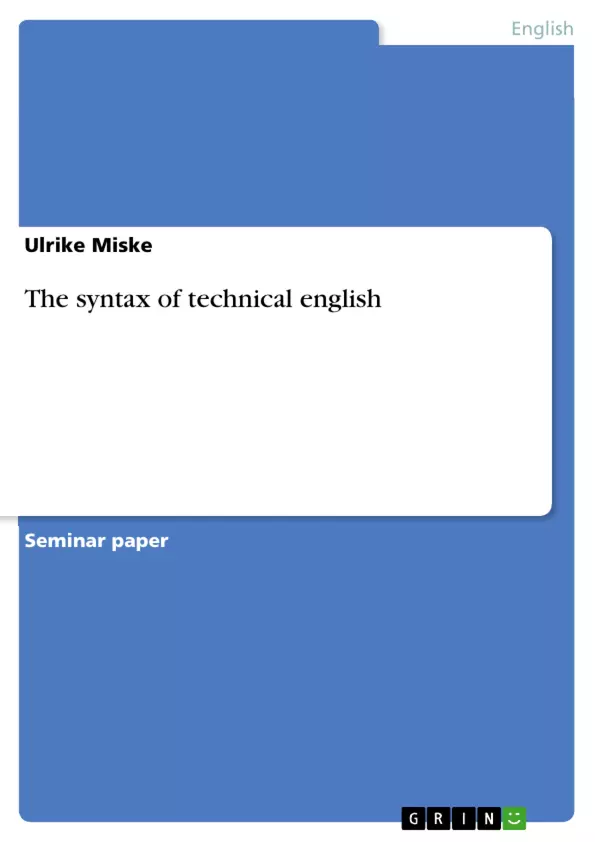English has not only become one of the most important languages for communication but has also gained ground in science. Yet, when referring to technical English, we do not mean a completely new language but one that is based on the general grammatical and syntactical rules of the English language. Technical English is merely English for a special purpose. It serves to meet the need of communicating ideas, concepts, results in a very efficient way which is not limited to native speakers of English but easily understandable by all working in this field. Godrey/Parr offer a good definition:
“The term ‘technical literature’ covers a wide variety of publications, all of which have as their object the conveying of information from one person to another. This information, to be of greatest use, must be conveyed as efficiently and as clearly as possible and herein lies the whole art of technical writing.”
Trying to convey information in an efficient and clear way, the question arises as to whether technical English shows certain characteristics to meet its purpose.
In this paper I will focus on the features of technical syntax and want to answer the question of how technical English achieves its purpose of being clear and efficient. I restricted my investigations to syntactical features concerning nouns and verbs. Using a variety of examples and texts I will furthermore prove how technical English tends to shortness, preciseness as well as comprehension by omitting any creative, literary paraphrasing.
Inhaltsverzeichnis (Table of Contents)
- Introduction
- Change in Syntax
- Nouns
- Nominalization
- Zero Article
- The s-genitive & Plural Forms
- Verbs
- Post-modifying Past Participles
- Infinitive + »ing« as a Verbal Noun and after Prepositions
- »NcI«<-structure
- Related Participle Construction
- The Passive
- Modal Verbs
- Nouns
- Examples of Technical English
- A report: The Preparation of Aspirin
- A manual: Motorola Dimension 1000 Binary GSC Pager
- Conclusion
- Bibliography
Zielsetzung und Themenschwerpunkte (Objectives and Key Themes)
This paper focuses on the characteristics of technical syntax in the English language. The author aims to answer the question of how technical English achieves its goal of being clear and efficient. The paper investigates the specific features of noun and verb syntax in technical English. The analysis seeks to demonstrate how technical English utilizes brevity, precision, and comprehensibility by avoiding creative literary paraphrasing. The main themes explored include:- The impact of nominalization on the clarity and efficiency of technical writing.
- The role of the zero article in achieving brevity and comprehensibility in technical English.
- The use of the Saxon genitive in technical English to condense information.
- The use of specific verb constructions and their impact on the syntax of technical writing.
- The overall tendency towards conciseness and precision in technical English writing.
Zusammenfassung der Kapitel (Chapter Summaries)
Introduction
This chapter introduces the topic of technical English and its significance in scientific communication. The author emphasizes that technical English is not a distinct language but rather a specialized form of the English language used for specific purposes. The chapter also introduces the concept of efficient and clear information transfer in technical writing and highlights the key question of how technical English achieves its purpose.Change in Syntax
Nouns
This section focuses on the use of nouns in technical English. It highlights the importance of nominalization as a means of condensing information and making technical writing more precise and efficient. The author provides examples to illustrate the use of nominal expressions and explains how they contribute to conciseness and clarity. The section also discusses the phenomenon of functional verbs, which are used in nominal constructions to further reduce sentence length and focus on core information. The author emphasizes the tendency towards an increase in nominal forms and a corresponding decline in verbal forms in technical English.Zero Article
This section examines the omission of the definite article "the" in technical English texts. The author presents examples to demonstrate how the zero article contributes to brevity and comprehensibility in technical writing. The section also discusses the rationale behind omitting articles, highlighting the aim to describe materials, things, and concepts without restriction. The author compares this usage to the standard practice in general English language use.The s-genitive & Plural Forms
This section explores the use of the Saxon genitive in technical English. The author explains its effectiveness in condensing information and provides examples to illustrate its application. The section also discusses the role of plural forms in technical English, highlighting the importance of brevity and clarity in expressing technical concepts.- Quote paper
- Ulrike Miske (Author), 2007, The syntax of technical english, Munich, GRIN Verlag, https://www.hausarbeiten.de/document/115291


